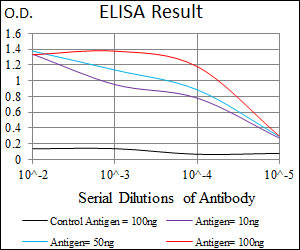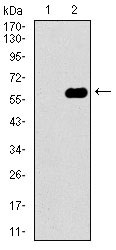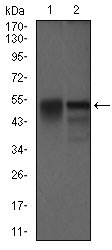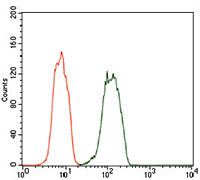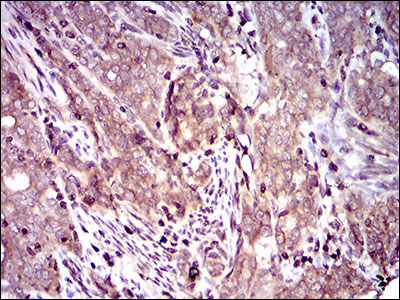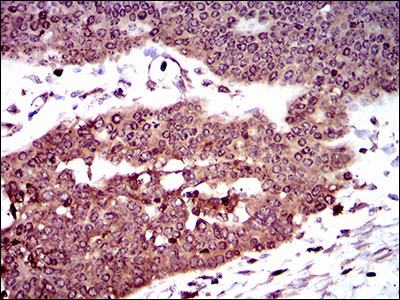DCTN4 Antibody
Purified Mouse Monoclonal Antibody
- SPECIFICATION
- CITATIONS
- PROTOCOLS
- BACKGROUND

Application
| WB, IHC, FC, ICC, E |
|---|---|
| Primary Accession | Q9UJW0 |
| Reactivity | Human, Mouse |
| Host | Mouse |
| Clonality | Monoclonal |
| Clone Names | 3G9D7 |
| Isotype | IgG1 |
| Calculated MW | 52.3kDa |
| Description | Dynactin 4 could have a dual role in dynein targeting and in ACTR1A/Arp1 subunit of dynactin pointed-end capping. Could be involved in ACTR1A pointed-end binding and in additional roles in linking dynein and dynactin to the cortical cytoskeleton.The dynactin complex binds cargo, such as vesicles and organelles, to cytoplasmic dynein for retrograde microtubule-mediated trafficking and could feasibly be involved in the copper-regulated trafficking of ATP7B. |
| Immunogen | Purified recombinant fragment of human DCTN4 (AA: 57-298) expressed in E. Coli. |
| Formulation | Ascitic fluid containing 0.03% sodium azide. |
| Gene ID | 51164 |
|---|---|
| Other Names | Dynactin subunit 4, Dyn4, Dynactin subunit p62, DCTN4 |
| Dilution | WB~~1/500 - 1/2000 IHC~~1/200 - 1/1000 FC~~1/200 - 1/400 ICC~~N/A E~~1/10000 |
| Storage | Maintain refrigerated at 2-8°C for up to 6 months. For long term storage store at -20°C in small aliquots to prevent freeze-thaw cycles. |
| Precautions | DCTN4 Antibody is for research use only and not for use in diagnostic or therapeutic procedures. |
| Name | DCTN4 (HGNC:15518) |
|---|---|
| Function | Part of the dynactin complex that activates the molecular motor dynein for ultra-processive transport along microtubules. |
| Cellular Location | Cytoplasm, cytoskeleton. Cytoplasm, cytoskeleton, microtubule organizing center, centrosome. Cytoplasm, cytoskeleton, stress fiber {ECO:0000250|UniProtKB:Q9QUR2}. Cytoplasm, cell cortex {ECO:0000250|UniProtKB:Q9QUR2}. Cytoplasm, myofibril, sarcomere {ECO:0000250|UniProtKB:Q8CBY8}. Note=Has a punctate cytoplasmic distribution as well as centrosomal distribution typical of dynactin (PubMed:10671518). Overexpression in cultured mammalian cells revealed colocalization with cortical actin, stress fibers, and focal adhesion sites, sites of potential interaction between microtubules and the cell cortex (By similarity). In skeletal muscles, costamere localization requires the presence of ANK2 (By similarity) {ECO:0000250|UniProtKB:Q8CBY8, ECO:0000250|UniProtKB:Q9QUR2, ECO:0000269|PubMed:10671518} |

Thousands of laboratories across the world have published research that depended on the performance of antibodies from Abcepta to advance their research. Check out links to articles that cite our products in major peer-reviewed journals, organized by research category.
info@abcepta.com, and receive a free "I Love Antibodies" mug.
Provided below are standard protocols that you may find useful for product applications.
References
Cell. 2008 Dec 26;135(7):1189-200. J Biol Chem. 2006 May 19;281(20):14006-14.
If you have used an Abcepta product and would like to share how it has performed, please click on the "Submit Review" button and provide the requested information. Our staff will examine and post your review and contact you if needed.
If you have any additional inquiries please email technical services at tech@abcepta.com.













 Foundational characteristics of cancer include proliferation, angiogenesis, migration, evasion of apoptosis, and cellular immortality. Find key markers for these cellular processes and antibodies to detect them.
Foundational characteristics of cancer include proliferation, angiogenesis, migration, evasion of apoptosis, and cellular immortality. Find key markers for these cellular processes and antibodies to detect them. The SUMOplot™ Analysis Program predicts and scores sumoylation sites in your protein. SUMOylation is a post-translational modification involved in various cellular processes, such as nuclear-cytosolic transport, transcriptional regulation, apoptosis, protein stability, response to stress, and progression through the cell cycle.
The SUMOplot™ Analysis Program predicts and scores sumoylation sites in your protein. SUMOylation is a post-translational modification involved in various cellular processes, such as nuclear-cytosolic transport, transcriptional regulation, apoptosis, protein stability, response to stress, and progression through the cell cycle. The Autophagy Receptor Motif Plotter predicts and scores autophagy receptor binding sites in your protein. Identifying proteins connected to this pathway is critical to understanding the role of autophagy in physiological as well as pathological processes such as development, differentiation, neurodegenerative diseases, stress, infection, and cancer.
The Autophagy Receptor Motif Plotter predicts and scores autophagy receptor binding sites in your protein. Identifying proteins connected to this pathway is critical to understanding the role of autophagy in physiological as well as pathological processes such as development, differentiation, neurodegenerative diseases, stress, infection, and cancer.
